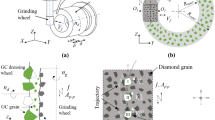Abstract
Since glass and ceramic materials have beneficial properties, they have gained more importance in numerous technical applications during the last 30 years. For example, nowadays, ceramics are used as artificial hip joints or as mechanical seals for highest relative speeds. Glass components are used for multitude of optical applications like cameras and reflectors. But besides a lot of advantages, the processing of these materials is very difficult. In particular, this contains the manufacturing of small components like microreactor plates or glass wafers with hundreds of small holes, too. Using ultrasonic-assisted grinding, the treatment can significantly be optimized and higher removal rates can be realized. For the generation of ultrasonic waves, often piezoactors are used that excite the grinding tools with vibrations of 20 kHz and amplitudes of a few microns (Markov 1966; Kuttruff 1988). Using an ultrasonic wave, the tool geometry is strongly restricted to guarantee the hybrid functionality (Siegert 2002; Dawe Instruments Ltd. 1967; Derks 1984). The paper describes a new way to calculate the design of tools suitable for their use in ultrasonic-assisted grinding. As a machining process, the manufacturing of spherical optics with cup-grinding wheels is selected.
Similar content being viewed by others
References
Markov AI (1966) Ultrasonic machining of intractable materials. Iliffe Books, London
Brecher C, Klocke F, Schug R, Weber A (2005) Ultraschalleinsatz—Produktionssteigerung bei der Zerspanung von Glas und Keramik, Industrie Diamanten Rundschau IDR, 39, Jahrgang, III/2005, Seite 244-250, ISSN 0935
Kuttruff H (1988) Physik und Technik des Ultraschalls. Hirtzel, Stuttgart
Wahl M (1999) Angewandte Strukturanalyse; Vorlesungsumdruck der Fachhochschule Aachen, Verlag Mainz, ISBN 3-89653-567-6
Siegert K (2002) Ultraschallbeeinflusstes Umformen metallischer Werkstoffe. Abschlussbericht des Sonderforschungsbereichs 543, Universität Stuttgart
Millner R (1987) Ultraschalltechnik Grundlagen und Anwendungen. Weinheim, Physik
Colwell L (1956) The effects of high-frequency vibrations in grinding. Transactions of the ASME, pp. 124–131
Dawe Instruments Ltd (1967) Dawe type 1138A ultrasonic machine tool, metalworking production 111(17):77
Derks PLLM (1984) The design of ultrasonic resonators with wide output cross-section. Dissertation, Technische Hochschule Eindhoven
Lazan BJ (1968) Damping of materials and members in structural mechanics. Pergamon, Oxford
Author information
Authors and Affiliations
Corresponding author
Rights and permissions
About this article
Cite this article
Brecher, C., Schug, R., Weber, A. et al. New systematic and time-saving procedure to design cup grinding wheels for the application of ultrasonic-assisted grinding. Int J Adv Manuf Technol 47, 153–159 (2010). https://doi.org/10.1007/s00170-009-2204-7
Received:
Accepted:
Published:
Issue Date:
DOI: https://doi.org/10.1007/s00170-009-2204-7




